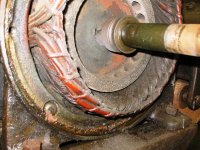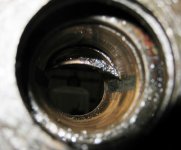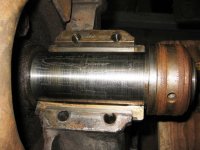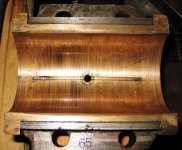Bradbrews4U
Aluminum
- Joined
- Sep 13, 2010
- Location
- Ann Arbor MI
This is the old GE motor on my Monarch Model A.
See this thread for more info:
http://www.practicalmachinist.com/vb/monarch-lathes/new-me-16-monarch-model-291778/
I probably should have posted it in this forum, but I haven't spent enough time here to figure out all the ins and outs yet.
Now that I know the motor works fine, I want to keep it that way. All the oil that was in the bearing end caps has run out in the process of it moving twice before getting to my shop. So, what oil is used for ring oiled electric motors?
Here is the only remaining tag on the motor: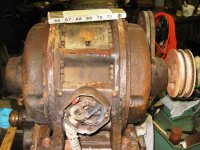
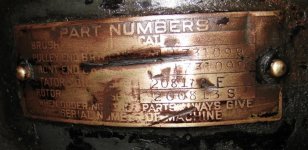
I suspect that is enough for someone to identify it, even though the main tag appears to have recently become a trophy for someone.
I did take amp measurements while running, but have not checked rpm yet.
Also, it seems likely that the ring oiler was removed from the pulley side. That end cap has modern bolts on it, and I can't see the ring. I can see the ring on the other side. It might be hiding in there, I have not checked. yet.
If it's missing, what is the best way to replace it? The old one looks like it was a braided copper ring?
I cleaned it out a bit since taking the pictures. All the oily spots on the machine seem covered with hair -?- (I can't really figure that out, and I'll leave it at that..)
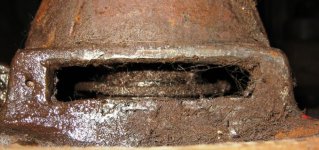

See this thread for more info:
http://www.practicalmachinist.com/vb/monarch-lathes/new-me-16-monarch-model-291778/
I probably should have posted it in this forum, but I haven't spent enough time here to figure out all the ins and outs yet.
Now that I know the motor works fine, I want to keep it that way. All the oil that was in the bearing end caps has run out in the process of it moving twice before getting to my shop. So, what oil is used for ring oiled electric motors?
Here is the only remaining tag on the motor:


I suspect that is enough for someone to identify it, even though the main tag appears to have recently become a trophy for someone.
I did take amp measurements while running, but have not checked rpm yet.
Also, it seems likely that the ring oiler was removed from the pulley side. That end cap has modern bolts on it, and I can't see the ring. I can see the ring on the other side. It might be hiding in there, I have not checked. yet.
If it's missing, what is the best way to replace it? The old one looks like it was a braided copper ring?
I cleaned it out a bit since taking the pictures. All the oily spots on the machine seem covered with hair -?- (I can't really figure that out, and I'll leave it at that..)






 I'm not sure, but I think I'm just going to weld the sleeve to the pulley and be done with it.
I'm not sure, but I think I'm just going to weld the sleeve to the pulley and be done with it.